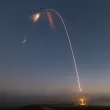Lift Off Time | April 27, 2021 – 03:20 UTC | 11:20 BJT |
|---|---|
Mission Name | Qilu 1, Qilu 4 Rideshare, a rideshare mission with two Qilu satellites as primary payloads |
Launch Provider | Shanghai Academy of Spaceflight Technology |
Customer | Shandong Province Government and others |
Rocket | Long March 6 (CZ-6) |
Launch Location | LA-16, Taiyuan Satellite Launch Center, China |
Payload mass | Unknown, up to 1080 kg for a SSO of 700 km |
Where did the satellites go? | A Sun-Synchronous Orbit (SSO) with unknown altitude |
Did they attempt to recover the first stage? | No, this is not a capability of the Long March 6 |
Where did the first stage land? | It crashed in the north Eastern region of China |
Did they be attempt to recover the fairings? | No, this is not a capability of the Long March 6 |
Were these fairings new? | Yes |
This was the: | – 5th flight of a Long March 6 rocket – 9th launch of any Long March rocket in 2021 – 34th orbital launch attempt of 2021 (33rd successful launch) |
Where to watch | There was no webcast |
How did it go?
As there has been no news about a launch failure, we assume that the rideshare mission with the primary payloads Qilu-1 and Qilu-4 has been successful. The Chinese Long March 6 (CZ-6) rocket lifted off at 03:20 UTC (11:20 BJT) from launch area 16 from the Taiyuan Satellite Launch Center in China. It is unknown if the satellites on this mission have been deployed into their correct orbits.
The Payloads
Unfortunately, there is not much public information about any of the satellites, other than they will be released into a Sun-synchronous low Earth orbit. Since the Long March 6 rocket is China’s small satellite launcher, it can be assumed that the payloads were either SmallSats or CubeSats, with one of them having a mass of just 37 kg.
Qilu-1 & Qilu-4
Qilu satellites are low Earth orbit reconnaissance satellites, with Qilu-1 utilizing a synthetic aperture radar (SAR) with a resolution of about 0.5m, and Qilu-4 utilizing a multispectral sensor with unknown resolution. The exact purpose these satellites will serve is unknown, but the local government of Shandong Province will be the customer using both satellites.
Other Satellites
As with most Chinese launches, there’s not much information about the payloads available. Besides Qilu-1 and Qilu-4, there will be 3 other satellites that will hitch a ride:
- Weina Xingkong Weixing (微纳星空卫星)
- Hangsheng-1 (航升一号)
- Taikong Caikuang Shiyan Xing (太空采矿试验星等)
Weina Xinkong Weixing is a micro-nano satellite with unknown purpose, while Taikong Caikuang Shiyan Xing is a space mining test satellite. Hangsheng-1 has a mass of 37 kg and could be the company’s (Hunan Hangsheng Satellite Technology) first test satellite of their planned constellation of 12 remote sensing satellites.
Long March 6
The Long March 6, or Chang Zheng 6 (CZ-6), is a liquid fueled small lift launch vehicle developed by the Shanghai Academy of Spaceflight Technology (SAST) together with the China Aerospace Science and Technology Corporation (CASC). The Long March 6 was developed for Sun-synchronous orbits and can put up to 1,080 kg of payloads into such an orbit at an altitude of 700 km.
With a hight of around 29.3 m and a width of 3.35 m at its widest point, it is reminiscent, not only in form, but also in payload capability, of Arianespace’s VEGA rocket.

LM-6’s First Stage
Long March 6’s first stage is 3.35 m in diameter and powered by one YF-100 engine that is fueled by highly refined kerosene (RP-1) and liquid oxygen (LOx). With a thrust of 1,200 kN at lift off and a specific impulse of 300 s and 335 s at sea level and in a vacuum, respectively, the YF-100 engine is an oxygen-rich staged combustion cycle engine.
LM-6’s Second Stage
The second stage is thinner with only 2.25 m in diameter and is powered by one YF-115 engine. Just like the YF-100, the YF-115 is powered by highly refined kerosene (RP-1) and liquid oxygen (LOx). It produces 180 kN in a vacuum at an ISP of 341.5 s. Again, just like the YF-100, the YF-115 is also an oxygen-rich staged combustion cycle engine.
LM-6’s Third Stage
It is unclear what engine or engines the third stage utilizes. Different sources and renders show either one engine that could run on the hypergolic fuels dinetrogen tetroxide (N2O4) and unsymmetrical dimethylhydrazine (UDMH), or four YF-85 engines that would run on hydrogen peroxide (H2O2) and highly refined kerosene (RP-1). On the website of the Shanghai Academy of Spaceflight Technology (SAST), they state that the third stage is powered by one YF-50E engine that runs on N2O4 and UDMH. Either way, this third stage has relight capability to put the payloads into custom orbits.



